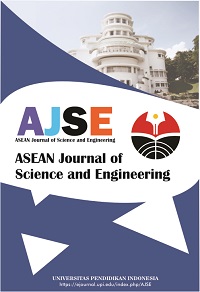Evaluation of FTIR, Macro and Micronutrients of Compost from Black Soldier Fly Residual: in Context of Its Use as Fertilizer
Abstract
Keywords
Full Text:
PDFReferences
Aktar, M. W., Sengupta, D., and Chowdhury, A. (2009). Impact of pesticides use in agriculture: their benefits and hazards. Interdisciplinary toxicology, 2(1), 1.
Butler, T. A., Sikora, L. J., Steinhilber, P. M., and Douglass, L. W. (2001). Compost age and sample storage effects on maturity indicators of biosolids compost. Journal of environmental quality, 30(6), 2141-2148.
Daman R., Singh, K. K., and Singh, B. (2016). Determination of Micronutrient in Vermicompost Prepared with Waste Rose Flower (Rosa berberia) Collected from Religious Places of Patna, Res J. Chem. Environ. Sci, 4, 37-43.
DeLaune, P. B., Moore Jr. P. A., and Lemunyon, J. L. (2006). Effect of chemical and microbial amendment on phosphorus runoff from composted poultry litter. Journal of Environmental Quality, 35, 1291–1296.
Diener, S., Studt Solano, N. M., and Roa Guiterrez, F. (2011). Biological Treatment of Municipal Organic Waste using Black Soldier Fly Larvae. Waste Biomass Valor, 2, 357-363.
Farhat, N., Elkhouni, A., Zorrig, W., Smaoui, A., Abdelly, C., and Rabhi, M. (2016). Effects of magnesium deficiency on photosynthesis and carbohydrate partitioning. Acta physiologiae plantarum, 38(6), 145.
Ge, B., McCartney, D., and Zeb, J. (2006). Compost environmental protection standards in Canada. Journal of Environmental Engineering and Science, 5(3), 221–234.
Geng, Y., Cao, G., Wang, L., and Wang, S. (2019). Effects of equal chemical fertilizer substitutions with organic manure on yield, dry matter, and nitrogen uptake of spring maize and soil nitrogen distribution. PloS One, 14(7), e0219512.
Gondek, M., Weindorf, D. C., Thiel, C., and Kleinheinz, G. (2020). Soluble Salts in Compost and Their Effects on Soil and Plants: A Review. Compost Science and Utilization, 28(2), 59-75.
Gransee, A., and Führs, H. (2013). Magnesium mobility in soils as a challenge for soil and plant analysis, magnesium fertilization and root uptake under adverse growth conditions. Plant and Soil, 368(1), 5-21.
Grattan, S. R., and Grieve, C. M. (1998). Salinity–mineral nutrient relations in horticultural crops. Scientia horticulturae, 78(1-4), 127-157.
Hao, X., and Benke, M. B. (2008). Nitrogen transformation and losses during composting and mitigation strategies. Dyn Soil, Dyn Plant, 2(1), 10-8.
Jurado, M. M., Suárez-Estrella, F., Vargas-García, M. C., López, M. J., López-González, J. A., and Moreno, J. (2014). Evolution of enzymatic activities and carbon fractions throughout composting of plant waste. Journal of environmental management, 133, 355-364.
Jurado, M., López, M. J., Suárez-Estrella, F., Vargas-García, M. C., López-González, J. A., and Moreno, J. (2014). Exploiting composting biodiversity: Study of the persistent and biotechnologically relevant microorganism from lignocellulose-based composting. Bioresource Technology, 162, 283-293.
Khan, A., Khan, S., Alam, M., Khan, M. A., Aamir, A., Qamar, Z., Rehman, Z.U., and Perveen, S. (2016). Toxic metal interactions affect the bioaccumulation and dietary intake of macro- and micro-nutrients. Chemosphere, 146, 121-128.
Khan, S. A., Mulvaney, R. L., Ellsworth, T. R., and Boast, C. W. (2007). The myth of nitrogen fertilization for soil carbon sequestration. Journal of Environmental Quality, 36(6), 1821-1832.
Khater, E. S. G. (2015). Some physical and chemical properties of compost. International Journal of Waste Resources, 5(01), 172.
Maas, E. V., and Grattan, S. R. (1999). Crop yields as affected by salinity. Agricultural drainage, 38, 55-108.
Mahmoodabadi, M., Yazdanpanah, N., Sinobas, L. R., Pazira, E., and Neshat, A. (2013). Reclamation of calcareous saline sodic soil with different amendments (I): Redistribution of soluble cations within the soil profile. Agricultural Water Management, 120, 30-38.
Prasad, R., and Shivay, Y. S. (2020). Calcium as a plant nutrient. International Journal of Bio-resource and Stress Management, 11(5), i-iii.
Saad, N. F. M., Maâ, N. N., Zain, S. M., Basri, N. E. A., and Zaini, N. S. M. (2013). Composting of mixed yard and food wastes with effective microbes. Jurnal Teknologi, 65(2), 89–95.
Savci, S. (2012). Investigation of effect of chemical fertilizers on environment. Apcbee Procedia, 1, 287-292.
Susic, M. (2016). Replenishing humic acids in agricultural soils. Agronomy, 6(4), 45.
Szewczuk, C., and Sugier, D. (2009). General characteristics and types of foliar fertilizers offered on the Polish market. Annales UMCS, Agricultura, 64(1), 29–36.
Tea, I., Genter, T., Naulet, N., Boyer, V., Lummerzheim, M., and Kleiber, D. (2004). Effect of foliar sulfur and nitrogen fertilization on wheat storage protein composition and dough mixing properties. Cereal Chemistry, 81(6), 759-766.
Vargas-García, M. C., Suárez-Estrella, F., López, M. J., and Moreno, J. (2010). Microbial population dynamics and enzyme activities in composting processes with different starting materials. Waste management, 30(5), 771-778.
White, P. J., and Brown, P. (2010). Plant nutrition for sustainable development and global health. Annals of botany, 105(7), 1073-1080.
Wu, L., and Ma, L. Q. (2002). Relationship between compost stability and extractable organic carbon. Journal of Environmental Quality, 31(4), 1323-1328.
DOI: https://doi.org/10.17509/ajse.v3i1.42798
Refbacks
- There are currently no refbacks.
Copyright (c) 2022 Universitas Pendidikan Indonesia

This work is licensed under a Creative Commons Attribution-ShareAlike 4.0 International License.












